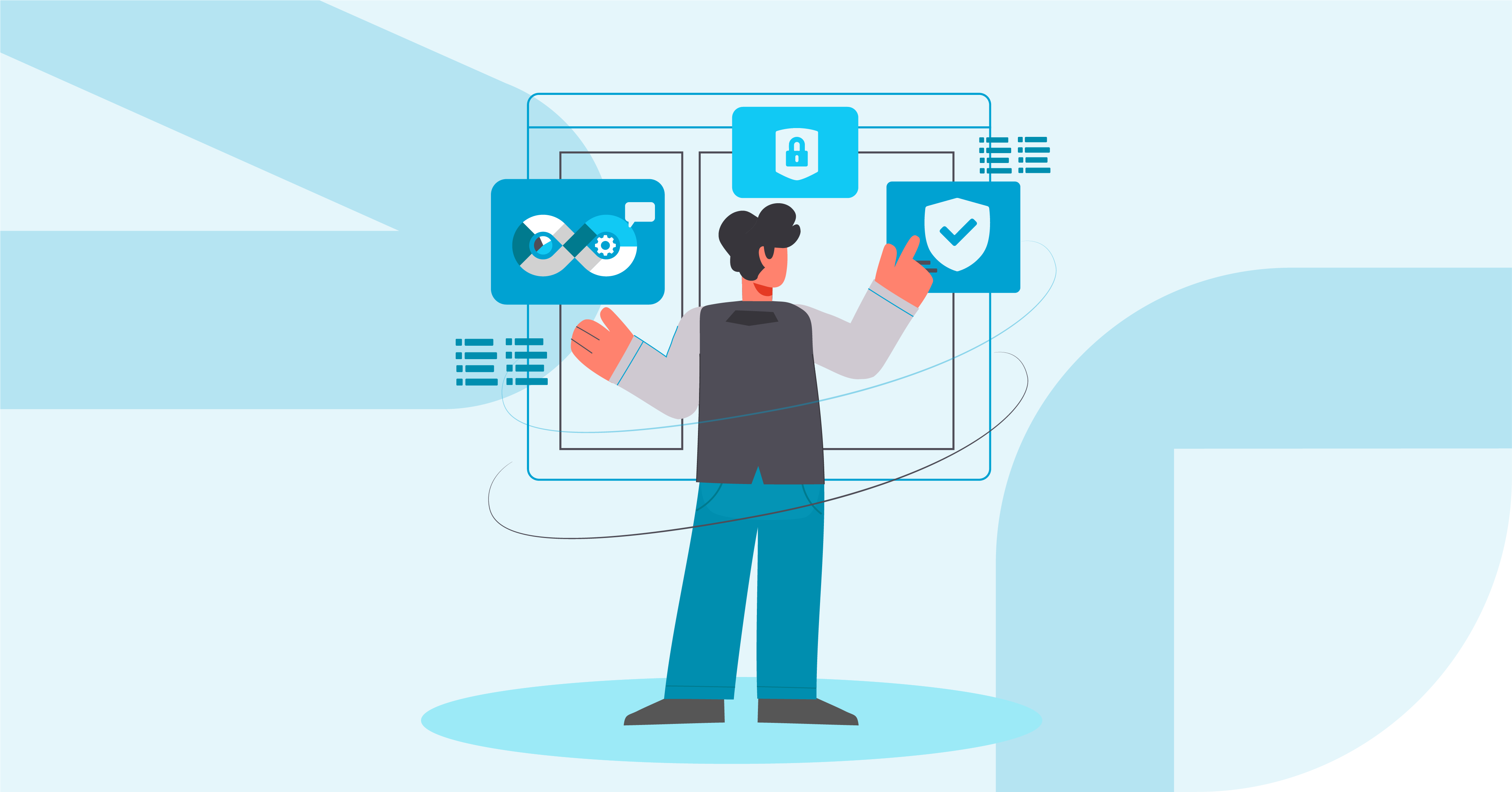With rising cyber threats, more and more enterprises are implementing DevSecOps practices. DevSecOps is the process of integrating security practices in every step of the software development lifecycle. As per Verified Market Research,” The market size of DevSecOps was USD 3.73 Billion in 2021 and is expected to reach USD 41.66 Billion by 2030.”
One of the main factors contributing to the market size of DevSecOps is the growing demand for adequate application security against cybercrimes. Furthermore, delivering secure software, without compromising on the speed of software delivery is a key requirement for business agility and market growth. If you are considering implementing DevSecOps, it is essential to learn the actual meaning of DevSecOps and the various steps to implement it.
This simple, yet comprehensive guide covers the following:
- What is DevSecOps?
- Steps for DevSecOps Implementation
- How to successfully transition to DevSecOps?
- Conclusion
RELATED COURSE
Understanding DevSecOps
Take our related course about the basics of DevSecOps. Mixing theory with hands-on application, you'll master the foundations!
What is DevSecOps?
DevSecOps is short for development, security, and operations. It is a way to integrate security into the software development process, from design to running applications in production.
The main goal of both DevOps and DevSecOps is to deliver software faster. So, what makes DevSecOps a better alternative to DevOps?
Over the years, there has been a vertical rise in cloud cyber-attacks. In fact, as per Accenture,” The losses due to cybercrime from 2019 to 2023 are projected to reach US$5.2 trillion.” Incorporating security in software development is no longer a choice; it’s necessary.
The DevOps model only focuses on project delivery speed and doesn’t explicitly address security threats that can compromise your business applications and your client’s and employee’s data.
With DevSecOps, you integrate security controls into DevOps practices. The main focus is securing the software development process from start to end without impacting the speed at which software is delivered.
With the DevSecOps approach, developers can identify and fix security issues before releasing software to production. This is what inspires business & IT leaders to invest in DevSecOps.
Well-known organizations like Facebook and Google are integrating DevSecOps in their workflows. Because of this, they're enjoying perks like higher productivity, better quality, and much more.
So far, we have stretched the main benefit that DevSecOps brings, but there are other known benefits of implementing DevSecOps. These are:
- Lost cost of doing security
- Secure design
- Faster recovery speed in case of a security issue or incident
- Better communication between DevOps and Security / Compliance teams
8 Easy Steps to Implement DevSecOps
Whether you are new to the concept of DevSecOps or have hands-on experience, integrating DevSecOps at your workplace is not an overnight process. It requires in-advance planning, the right strategy, and the best implementation practices.
Herein, we have explained 8 simple steps to implement DevSecOps seamlessly.
1. Planning
The saying,” Planning is the key to success,” fits well here. Analyze your organization's initial security posture and draft a strategic plan. Your plan must include security testing throughout the software development & delivery process. Also, focus on acceptance security test criteria, threat models, and planning of interfacing security processes like pen-testing etc.
2. Developing
After making a strategic plan, follow the “how to do it” approach instead of “what to do.” Use multiple resources to provide guidance. Plus, you must implement a code review system like SAST testing to boost uniformity— this is an essential DevSecOps element.
3. Building
The next step you must follow is to integrate security testing into build automation tools. Such security testing, like Software Component Analysis (SCA) identifies vulnerable libraries and gives feedback to DevOps engineers before the software is released to production, improving the security of your application without hampering the speed at which software is conceived.
4. Testing:
This is a critical DevSecOps implementation step. In this stage, you must use dynamic application security testing (DAST) tools for software testing at runtime. Such tools test real-world security vulnerabilities like cross-site scripting, SQL injection, etc.
5. Deploying
The next essential step is integrating IaC, Infrastructure as Code tools, to execute the deployment process. Infrastructure deployments with IaC prevent runtime issues by minimizing errors arising from manual activities. Furthermore, it helps organizations control and manage the infrastructure in an automated way instead of doing it manually.
6. Operating
The software might be secure at a point in time, but that doesn’t guarantee secure software in future. Take, for example, zero-day vulnerabilities. These vulnerabilities have proven to really impact business (think about incidents like Log4J) and can put a freeze on your business. To safeguard your organisation from zero-day exploits, the operations team must use IaC tools to identify security bugs like broken authentication and sensitive data exposure.
7. Monitoring
This is a vital step and should not be missed. You must implement a reliable and continuous monitoring system that identifies security flaws and prevents breaches in your organization.
8. Adapting
The last and the most crucial step is to adapt to the changing trends and continuous improvement to achieve the desired results. Think about implementing threat intelligence in your workflow. Not only threat intel from external sources but feedback from internal sources by executing red teaming exercises and independent security testing like pen-testing.
Make sure to follow every step properly for the seamless integration of DevSecOps. To know more about DevSecOps, click here.


How to Successfully Transition to DevSecOps?
Needless to say, DevOps practices have largely contributed to faster software delivery. However, the growing need for application security in a fast-paced world requires organizations to integrate security into the DevOps process. Thus, DevSecOps is an evolution of DevOps that enables software delivery faster and securely.
However, transiting from DevOps to DevSecOps is easier said than done. You need to have the right mindset and approach to make this culture shift seamless. If your organization does not transit to DevSecOps smoothly, it might not benefit you. A few tips to transition from DevOps to DevSecOps successfully are as follows:
Understand the significant cultural change involved
Adopting DevSecOps practices requires a complete cultural shift. Most likely, teams may be reluctant to accept this significant cultural change. So making them understand the importance of application security and other benefits associated with DevSecOps.
Practice secure coding
Even the smallest security bug can ruin the most advanced applications. To avoid this, train developers to implement secure coding practices. Secure coding will result in no to fewer application security issues.
Implement the right security automation
You cannot expect your developers to become security experts overnight. Besides training your developers regarding secure code practices, integrate automated security tools to scan the code and identify vulnerabilities throughout the development process.
Evaluate progress
Evaluating your progress will let you know how well you transition to DevSecOps. Measure the metrics of different Software Development Life Cycle (SDLC) phases, like the total time to develop, test, or deploy the application after adopting the DevSecOps approach, combined with identified and solved security issues. This will help you track the productivity of your team.
Takeaway
From increasing sales to lowering costs and more effective compliance, DevSecOps offers a host of benefits. However, implementing DevSecOps is not as easy as it sounds.
It requires a complete cultural and philosophical change in your organization’s traditions and teamwork. For a successful DevSecOps implementation, one must have in-depth knowledge, proper strategy, a solid plan, and some best practices to follow.
We hope this blog has shed light on the DevSecOps implementation steps. If you plan to make a cultural shift towards DevSecOps, we can help. Everable is a skill-building platform that provides various solutions to upskill your team.
For more information, schedule a free demo.
